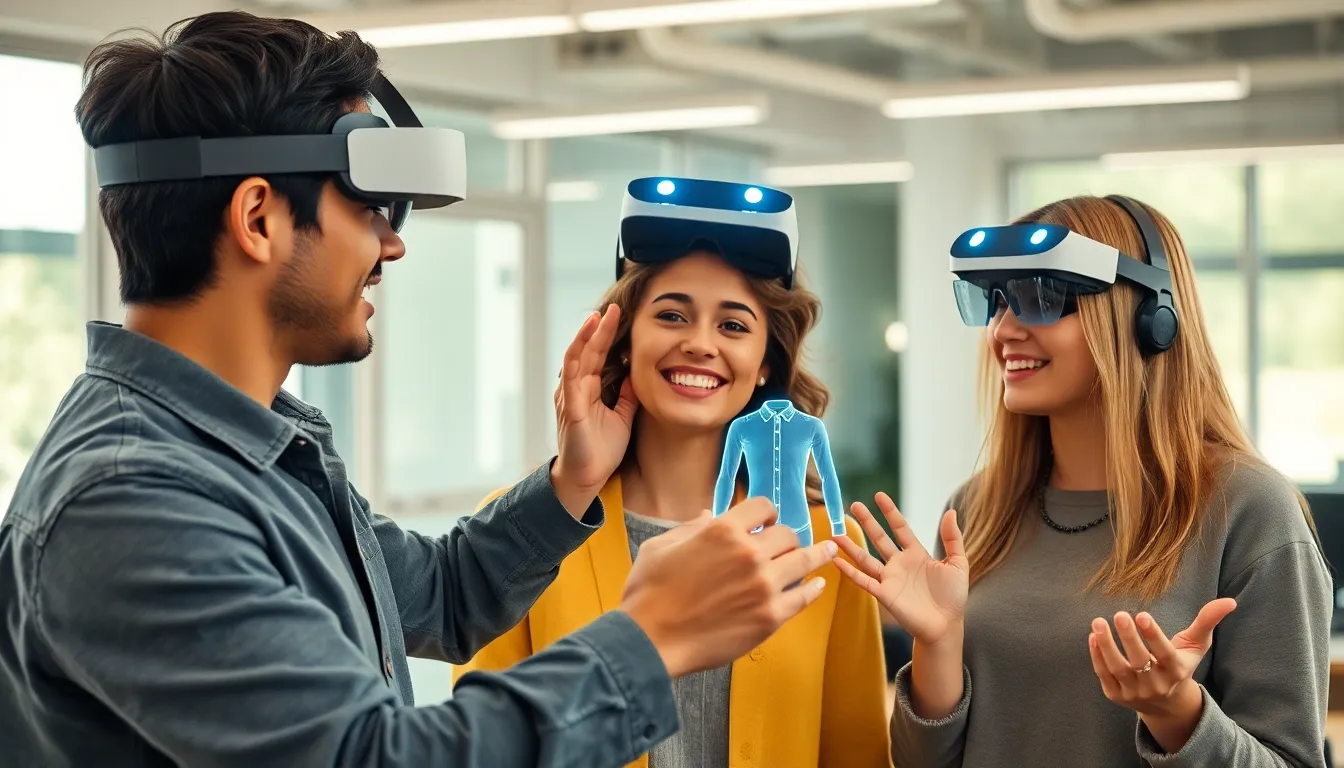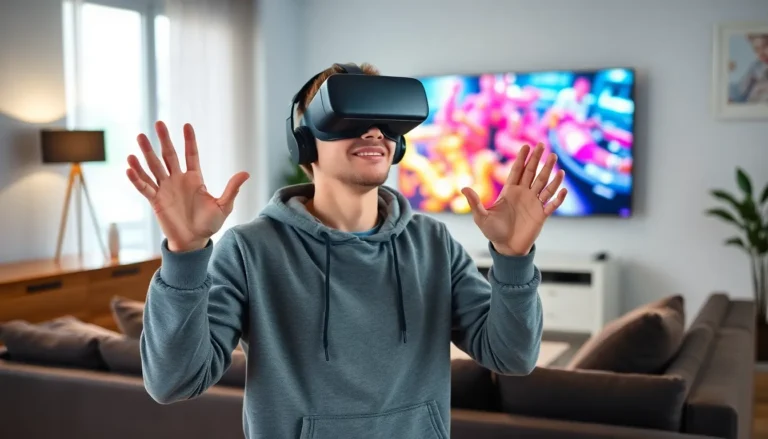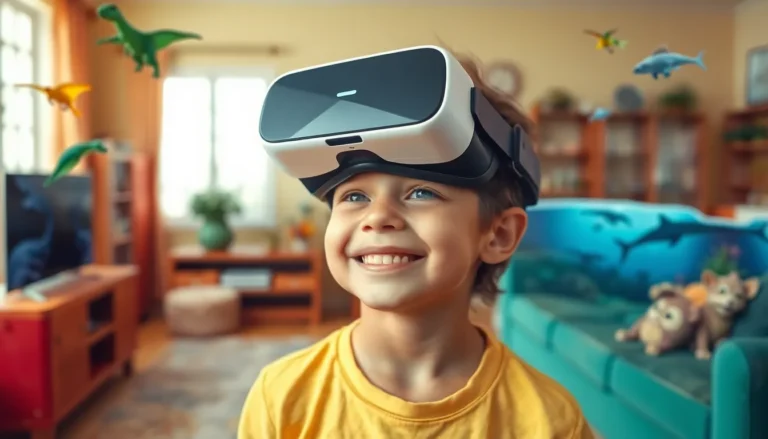Imagine a world where your favorite video game characters pop up in your living room, or where you can try on clothes without ever stepping foot in a store. Welcome to the captivating realm of mixed reality. This innovative technology blends the digital and physical worlds, creating experiences that are as entertaining as they are transformative.
Table of Contents
ToggleOverview of Mixed Reality
Mixed reality combines digital content with the physical world, creating a seamless interaction between both environments. This technology enhances reality by overlaying digital objects, allowing users to engage with virtual elements in real time. Users experience a new level of immersion, bridging the gap between physical spaces and digital experiences.
Applications of mixed reality span various fields, including gaming, education, healthcare, and retail. For example, in gaming, players see characters interact with their surroundings, promoting deeper engagement. In education, students visualize complex concepts through interactive simulations, enhancing their learning experience. In healthcare, surgeons use mixed reality for precise operations by viewing digital overlays of anatomy.
The hardware for mixed reality includes headsets and glasses, integrating advanced sensors and cameras. Devices such as Microsoft HoloLens and Magic Leap One enable users to explore mixed reality applications effectively. These devices track user movements and environments, creating a responsive experience that adjusts to physical space.
Content creation for mixed reality requires specialized tools and expertise. Developers design applications that capitalize on spatial awareness, user interaction, and real-world integration. As demand for immersive content grows, more industries invest in mixed reality solutions, fostering innovation and creativity.
Adoption rates of mixed reality technologies have increased significantly in recent years. According to research, the global mixed reality market could surpass USD 135 billion by 2026, driven by advancements in technology and heightened consumer interest. This growth indicates a shift toward more interactive and engaging experiences that redefine how individuals perceive and interact with digital content.
Key Technologies Behind Mixed Reality

Mixed reality relies on several key technologies that enable seamless interaction between the digital and physical worlds. These technologies contribute to creating immersive experiences, enhancing user engagement in various applications.
Augmented Reality
Augmented reality enhances the physical environment by overlaying digital content onto it. It utilizes devices like smartphones, tablets, and smart glasses to display information, images, or animations in real-time. Users can see virtual objects while interacting with their surroundings. Popular applications include mobile games like Pokémon GO, which integrate digital characters into real-world settings. Businesses employ augmented reality for marketing campaigns and product demonstrations, allowing consumers to visualize products before purchase. Analysts predict significant growth in augmented reality, with the market expected to reach USD 61.39 billion by 2023, showcasing its expanding role across industries.
Virtual Reality
Virtual reality immerses users in a completely digital environment, isolating them from the physical world. Headsets are central to this technology, equipped with sensors that track head movements and adjust the display accordingly. This results in a fully immersive experience, engaging users in simulated environments for gaming, training, or therapy. Educational institutions are leveraging virtual reality to provide students with interactive learning experiences, such as exploring historical sites or conducting virtual science experiments. The global virtual reality market is projected to surpass USD 44.7 billion by 2024, indicating a strong demand for realistic digital experiences across diverse sectors.
Applications of Mixed Reality
Mixed reality showcases a wide array of applications that significantly impact various industries. Education, healthcare, and entertainment utilize this innovative technology, enhancing experiences and interactions.
Education and Training
Educational institutions leverage mixed reality to create immersive learning environments. Visualization of complex subjects, like anatomy or physics, occurs through interactive 3D models. Students can explore intricate concepts hands-on, boosting retention rates. Training simulations enable professionals, such as pilots and surgeons, to refine their skills in safe, controlled settings. Industry experts indicate that the effectiveness of mixed reality in education contributes to improved engagement and a better understanding of crucial material.
Healthcare
In healthcare, mixed reality enhances patient outcomes and training methodologies. Surgeons utilize AR overlays during procedures, allowing real-time guidance and improved precision. Medical students benefit from lifelike simulations, fostering skill development without risk to patients. Remote consultations with specialists also become streamlined, as mixed reality facilitates better communication between patients and doctors. Reports reveal that this technology not only accelerates learning but also minimizes errors in clinical settings.
Entertainment and Gaming
Mixed reality transforms entertainment, particularly in gaming. Players interact with digital characters and environments as if they exist in their physical space. This blending of real and virtual elements creates unique gaming experiences that engage users more deeply. Popular games demonstrate the immersive potential of mixed reality, captivating audiences across generations. Financial forecasts suggest that the gaming sector will continue to expand, reinforcing the demand for innovative mixed reality experiences.
Challenges in Mixed Reality
Mixed reality presents various challenges that hinder its widespread adoption and effectiveness. Addressing these obstacles is crucial for future advancements in the technology.
Technical Limitations
Technical limitations pose significant hurdles for mixed reality. Devices often face issues like limited field of view, impacting immersion. Additionally, many mixed reality headsets require high processing power, constraining accessibility for average users. Latency can disrupt real-time interaction, leading to frustrating experiences. Hardware compatibility further complicates matters, as not all systems integrate seamlessly with existing technologies. The need for specialized skills in content creation presents another barrier, increasing the time and cost involved in developing applications.
User Experience Concerns
User experience concerns also affect mixed reality adoption. Many users report discomfort after prolonged use, citing factors like motion sickness and eye strain. Understanding the learning curve is vital, as new users may struggle with complex interfaces. Privacy issues arise as mixed reality devices collect user data, raising concerns over security. Social acceptance remains a challenge, with some individuals feeling uneasy about blending digital elements into their daily lives. Engaging with familiar applications may mitigate these concerns, improving overall satisfaction in mixed reality experiences.
Future Trends in Mixed Reality
Mixed reality continues to evolve, showcasing several key trends shaping its future. Advancements in hardware play a significant role. Companies like Microsoft and Magic Leap are developing increasingly sophisticated headsets with enhanced sensors, which support more immersive experiences.
Content creation is becoming more accessible. Tools designed for developers are simplifying the process of building mixed reality applications. This accessibility encourages innovation across sectors, leading to unique user experiences.
The gaming industry is expected to see significant growth. With a projected value of USD 135 billion by 2026, innovative mixed reality games will offer more realistic interactions. Players will increasingly connect with characters and environments in ways that blur the line between the physical and digital worlds.
Healthcare applications are on the rise. Surgeons are using mixed reality for more precise operations. Trends show that medical training will incorporate real-time simulations to improve skill acquisition.
Education is transforming through mixed reality solutions. Students engage with complex subjects using interactive 3D models, enhancing understanding and retention. This trend will likely expand, leading to more institutions adopting mixed reality tools in their curricula.
User experience enhancements are a priority. Developers are addressing concerns such as motion sickness and discomfort during prolonged use. These efforts are crucial for encouraging widespread adoption and acceptance of mixed reality technologies.
Finally, social acceptance is gradually shifting. As familiarity with digital elements increases, more individuals may feel comfortable integrating them into their lives. This gradual acceptance may significantly influence the development and deployment of future mixed reality applications.
Mixed reality is rapidly evolving and stands at the forefront of technological innovation. Its ability to blend the digital and physical worlds opens up remarkable possibilities across various sectors. As industries embrace this technology, the potential for enhanced user experiences continues to grow.
Despite the challenges that remain, advancements in hardware and content creation tools are paving the way for broader adoption. The future looks promising as mixed reality transforms education, healthcare, and entertainment, creating immersive environments that engage users in unprecedented ways.
With ongoing improvements and increasing social acceptance, mixed reality is set to redefine how individuals interact with technology in their daily lives.




